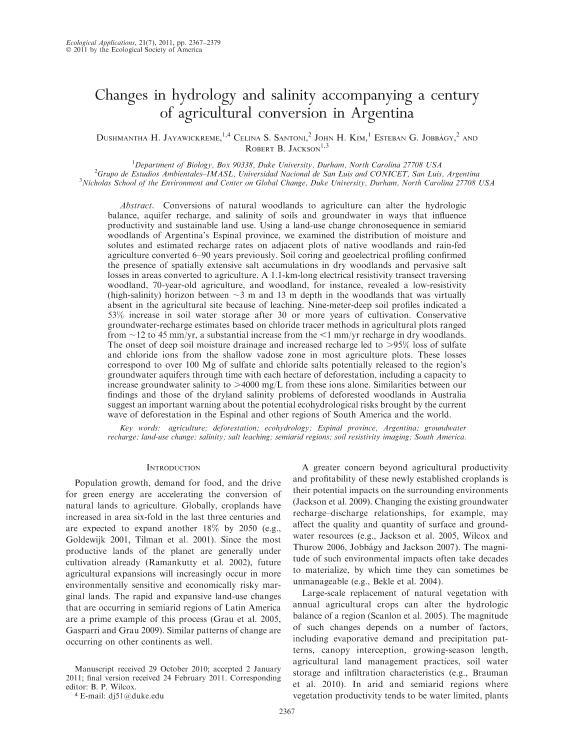Artículo
Changes in hydrology and salinity accompanying a century of agricultural conversion in Argentina
Jayawickreme, Dushmantha; Santoni, Celina Sofia ; Kim, John H.; Jobbagy Gampel, Esteban Gabriel
; Kim, John H.; Jobbagy Gampel, Esteban Gabriel ; Jackson, Robert B.
; Jackson, Robert B.
 ; Kim, John H.; Jobbagy Gampel, Esteban Gabriel
; Kim, John H.; Jobbagy Gampel, Esteban Gabriel ; Jackson, Robert B.
; Jackson, Robert B.
Fecha de publicación:
10/2011
Editorial:
Ecological Society of America
Revista:
Ecological Applications
ISSN:
1051-0761
e-ISSN:
1939-5582
Idioma:
Inglés
Tipo de recurso:
Artículo publicado
Clasificación temática:
Resumen
Conversions of natural woodlands to agriculture can alter the hydrologic balance, aquifer recharge, and salinity of soils and groundwater in ways that influence productivity and sustainable land use. Using a land-use change chronosequence in semiarid woodlands of Argentina's Espinal province, we examined the distribution of moisture and solutes and estimated recharge rates on adjacent plots of native woodlands and rain-fed agriculture converted 6–90 years previously. Soil coring and geoelectrical profiling confirmed the presence of spatially extensive salt accumulations in dry woodlands and pervasive salt losses in areas converted to agriculture. A 1.1-km-long electrical resistivity transect traversing woodland, 70-year-old agriculture, and woodland, for instance, revealed a low-resistivity (high-salinity) horizon between ∼3 m and 13 m depth in the woodlands that was virtually absent in the agricultural site because of leaching. Nine-meter-deep soil profiles indicated a 53% increase in soil water storage after 30 or more years of cultivation. Conservative groundwater-recharge estimates based on chloride tracer methods in agricultural plots ranged from ∼12 to 45 mm/yr, a substantial increase from the <1 mm/yr recharge in dry woodlands. The onset of deep soil moisture drainage and increased recharge led to >95% loss of sulfate and chloride ions from the shallow vadose zone in most agriculture plots. These losses correspond to over 100 Mg of sulfate and chloride salts potentially released to the region's groundwater aquifers through time with each hectare of deforestation, including a capacity to increase groundwater salinity to >4000 mg/L from these ions alone. Similarities between our findings and those of the dryland salinity problems of deforested woodlands in Australia suggest an important warning about the potential ecohydrological risks brought by the current wave of deforestation in the Espinal and other regions of South America and the world.
Archivos asociados
Licencia
Identificadores
Colecciones
Articulos(IMASL)
Articulos de INST. DE MATEMATICA APLICADA DE SAN LUIS
Articulos de INST. DE MATEMATICA APLICADA DE SAN LUIS
Citación
Jayawickreme, Dushmantha; Santoni, Celina Sofia; Kim, John H.; Jobbagy Gampel, Esteban Gabriel; Jackson, Robert B.; Changes in hydrology and salinity accompanying a century of agricultural conversion in Argentina; Ecological Society of America; Ecological Applications; 21; 7; 10-2011; 2367-2379
Compartir
Altmétricas



